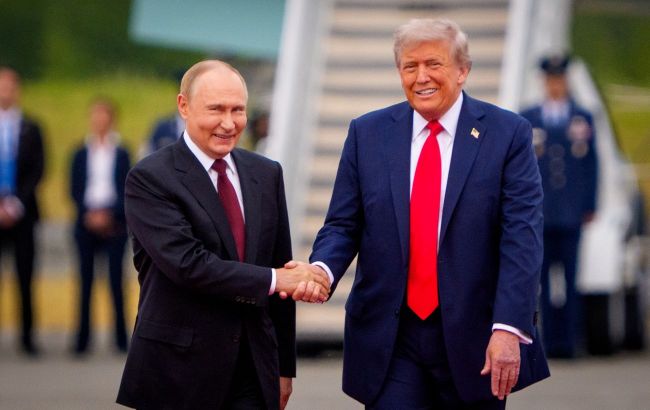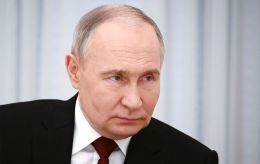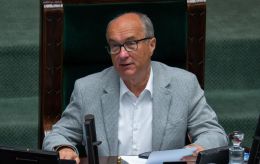From Alaska to Budapest: Inside Trump's new push to deal with Putin
 Donald Trump and Vladimir Putin in Alaska (photo: Getty Images)
Donald Trump and Vladimir Putin in Alaska (photo: Getty Images)
US President Donald Trump has announced a new meeting with Vladimir Putin.
RBC-Ukraine looks back at their previous contacts and explores what the upcoming summit could bring.
Key questions:
- How did Trump try to push Russia toward a quick end to the war?
- What came out of the Trump-Putin meeting in Alaska?
- How did Putin stall for time in talks with Trump?
After a brief pause in negotiations on ending the Russian-Ukrainian war, a new phase of activity has begun. US President Donald Trump and Russian dictator Vladimir Putin plan to meet in person again – this time in Budapest.
Much remains unknown — from the agenda of the talks to purely logistical details. Hungary is surrounded by NATO and EU member states that could block overflights or even arrest Putin under the International Criminal Court's warrant. The Russian leader has several possible routes to reach Budapest. He could travel through Germany and the Czech Republic or Austria, through Belarus and Poland, or via a southern route across the Black Sea to Bulgaria and then through Serbia.
Germany, Czechia, and Poland have taken a firmly anti-Russian stance. Austria seeks to remain neutral, while Bulgaria, though supportive of Ukraine, has not fully severed ties with Moscow. Which route Putin will take remains unclear. However, if the US specifically requests a safe air corridor for him, it is doubtful that any country would dare to block its airspace.
Still, judging by the previous course of Trump-Putin negotiations, some conclusions can already be drawn.
Taking Putin head-on
Donald Trump began restoring contacts with Russia just a month after his inauguration. On February 11, his special envoy, Steven Witkoff, made his first visit to Moscow and met with Putin. As a goodwill gesture, Russia released detained American citizen Mark Fogel. The very next day, Trump held a personal conversation with Putin.
This later evolved into further consultations between the US, Ukraine, and Russia in Saudi Arabia. Over several rounds of talks, the parties drafted two communiqués outlining a 30-day moratorium on strikes — one between Ukraine and the US, and another between the US and Russia. The documents were signed on March 11. At the same time, Witkoff made another trip to Russia, and Trump spoke with Putin again. During that period, Russia and the US also restored embassy operations and intelligence contacts.
However, the agreements on a mutual halt to strikes were never fully implemented. During a conversation with Trump on March 18, Putin verbally agreed to stop attacks on Ukraine's energy infrastructure but conditioned any further peace settlement on several demands.
Among the key ones were ending military aid to Ukraine and canceling mobilization in the country. In addition, leaks in the US media suggested that Russia had demanded Washington’s legal recognition of the Ukrainian territories it had seized.
That was when Putin first used one of his favorite tactics against Trump — dragging out technical negotiations indefinitely, while Russia avoided new sanctions and continued its offensive against Ukraine.
Misleading the Kremlin
Subsequently, talks on ending the Russian-Ukrainian war took a back seat, although the foreign ministers of both countries — Marco Rubio and Sergey Lavrov — discussed them twice in April.
At the same time, dialogue between Russia and the US on joint projects intensified. This track involved the previously mentioned Steven Witkoff and Kirill Dmitriev, head of the Russian Direct Investment Fund. Discussions focused on cooperation in the Arctic, rare earth metals, space, and liquefied natural gas. During this period, Witkoff met with Putin twice more.
In May, the US attempted to organize new negotiations between Ukraine and Russia in Istanbul. To this end, Rubio and Lavrov held three additional conversations, along with a third discussion between Trump and Putin.
On May 8, the 80th anniversary of the victory over Nazism, leaders of several European countries issued an ultimatum to Putin in Kyiv: to begin a ceasefire by May 12. The Russian president rejected this demand but offered an alternative — direct talks in Istanbul on May 15.
In response, Volodymyr Zelenskyy announced that he would personally go to Istanbul and wait there for Putin.

Steven Witkoff (right) and Kirill Dmitriev (photo: Getty Images)
Trump also supported the idea and even hinted at his possible presence in Istanbul, putting Putin in a difficult position. The Russian dictator did not appear in Turkey. On May 19, during another — already the third — conversation with Trump, he once again claimed that Russia supports a peaceful resolution to the "Ukrainian crisis."
The dictator stated that Russia was allegedly ready to work with Ukraine on a memorandum "regarding a possible future peace agreement, outlining a number of points: principles of settlement, possible timelines for concluding a peace deal, including a potential temporary ceasefire."
Trump responded by shifting responsibility onto Kyiv and Moscow. He said, that Russia and Ukraine will immediately begin negotiations on a ceasefire and, more importantly, on ending the war. According to him, the terms will be agreed upon by both sides, because they know the details of the talks that no one else will know.
Direct negotiations between Ukraine and Russia, without the leaders' participation, did take place in Istanbul on June 2, but were limited to humanitarian issues — prisoner exchanges and the return of Ukrainian children.
During the talks, Russia presented Ukraine with a draft memorandum containing demands that, if accepted, would have amounted to surrender. Kyiv proposed holding a leaders’ meeting, possibly with Trump's participation. Russia has not agreed to this idea. Between June and July, three more humanitarian meetings took place in Istanbul, observed by the US without direct involvement.
Meanwhile, Trump and Putin spoke personally three times. Once, it was on the occasion of the US president's birthday. By that stage, their discussions also included the situation around Iran. Nevertheless, Trump continued to resist imposing sanctions on Russia, limiting himself to general statements regarding Moscow.
Threatening tariffs
The situation shifted somewhat on July 14, when Trump announced that if Russia and Ukraine did not reach an agreement within 50 days — by the end of the August recess — the US would impose secondary tariffs on Russia.
"So based on that, we're going to be doing secondary tariffs if we don't have a deal in 50 days – it’s very simple. They'll be at 100%." he said during a joint press conference with NATO Secretary-General Mark Rutte.
Trump later shortened the timeframe to "10–12 days," which was set to expire on August 8. However, two days earlier, Steven Witkoff arrived in Moscow again. The secondary trade tariffs were never implemented. Instead, a personal meeting between Trump and Putin in Alaska was announced for August 15.
The meeting between the two leaders was tense. According to the Financial Times, Putin gave Trump a "lecture" to assert Russia’s historical claims on Ukraine. The outlet, citing White House sources, reported that the Russian dictator immediately rejected a proposal to ease sanctions in exchange for a ceasefire, demanding that the war end only through Ukraine’s capitulation and the transfer of significant portions of the Donetsk and Luhansk regions.
This angered Trump, who even "threatened" to walk out of the talks. Nevertheless, after the summit, he once again claimed he had an extremely productive meeting with Putin and had agreed on many points.
"And there are just a very few that are left. Some are not that significant. One is probably the most significant, but we have a very good chance of getting there," the US president said.
Immediately after the meeting, Trump called Ukrainian President Volodymyr Zelenskyy and several European leaders. On August 18, Zelenskyy visited Washington and met with Trump at the White House. This was followed by multilateral talks involving Zelenskyy, Trump, and European leaders. Trump also spoke with Putin by phone afterward.
According to AFP sources, Putin allegedly agreed to meet with Zelenskyy and confirmed this during a phone call with Trump on August 19.
"The leaders discussed the idea of exploring the possibility of elevating the level of Moscow and Kyiv representatives in the negotiations," Putin aide Yuri Ushakov said after the call.
However, Russian Foreign Minister Sergey Lavrov later clarified that the Kremlin proposed raising the level of delegation representation and putting not only military and humanitarian issues but also "political aspects of the settlement" on the agenda. This signaled a return to Russia’s old tactic of delaying negotiations. On August 22, Zelenskyy directly stated that Russia was trying to avoid a leaders’ summit.
"It is at the leaders' level that the question of ending the war must be resolved. But we can see now that the Russians are doing everything to prevent the meeting," Zelenskyy said.
Trump then cooled his focus on the Russian-Ukrainian war. No substantive negotiations took place, and eventually the topic was pushed aside by other issues on the US agenda.
The next wave of activity came on October 13. Speaking at the Israeli Knesset, Trump said that it would be great to conclude a peace treaty with Iran, but noted that before that, it is necessary to "get Russia done." Shortly afterward, he had another phone call with Putin and announced the upcoming meeting in Budapest.
What to expect from the new meeting
It has been two months since the Trump-Putin meeting in Alaska. The front lines remain largely static, but the Kremlin continues strikes on Ukraine's energy infrastructure, with Kyiv responding in kind. Meanwhile, Ukraine has secured stable supplies of American weapons.
At the same time, the US president and his team have stepped up rhetoric against Russia. US Secretary of Defense Pete Hegseth promised Russia serious consequences if it does not end the war in Ukraine.
"If this war does not end, if there is no path to peace in the short term, then the United States, along with our allies, will take the steps necessary to impose costs on Russia for its continued aggression," Hegseth said.
Additionally, Treasury Secretary Scott Bessent revived the topic of secondary trade tariffs against buyers of Russian energy. This refers to the Graham-Blumenthal bill, which would allow the US to impose 500% tariffs on Russia's trading partners and has been under consideration in Congress for several months.
There is no doubt that Russia will prepare carefully for the Budapest meeting. There is always the risk of manipulation or a destructive influence by Putin on Trump during their personal encounter, says Volodymyr Dubovyk, director of the Center for International Studies at Odesa National University.
"Putin is experienced in these matters and knows Trump well. They also share a personal history, usually marked by Trump's sympathy and respect. Putin will try to ease the tension that has arisen recently. He will make promises, say again that he sincerely wants to end the war, and portray Ukraine as the only obstacle," Dubovyk said.
According to him, Trump is vulnerable to such tactics, so this meeting carries certain risks for Ukraine.
In previous negotiations, the Kremlin consistently found ways to avoid a real end to the war. It is likely that Putin will attempt the same this time. Ultimately, the question is what negotiating trick Putin will use on Trump and whether Trump will fall for it again.

